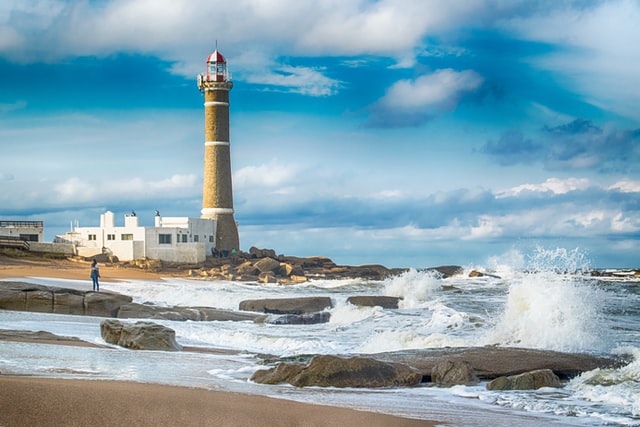Uruguay is one of the most charming and among the easiest countries in South America to visit. In our travel guide to Uruguay, you’ll get a feel for how this South American country is safe to visit, well organised and moves at a peaceful pace. You can easily spend a couple of weeks easing into life in Uruguay and exploring its wine regions. As a bare minimum, plan to spend a couple of days in Montevideo and visiting the wine route of Canelones, and a couple more in the coastal regions of Maldonado or the riverside regions of Colonia.
Guide to visiting Uruguay and experiencing its wines in situ
Montevideo’s Carrasco International Airport has direct flights to most Latin American capitals and international connections, and is just 20 minutes from the capital (by taxi or bus). If you are arriving by boat (from Buenos Aires or Brazil), there are three busy ports with international arrivals in Uruguay: Montevideo, Punta del Este and Colonia del Sacramento. Major cities are also served by international bus services, and local buses are comfortable and regular. Hire cars are widely available and driving is a joy in Uruguay — especially with the country’s fascination for interesting curved bridges and roundabouts.
Wine Routes
The most organised wine routes are in Montevideo and Canelones, Colonia and Maldonado. If you are visiting Colonia, you can spend a day visiting the wineries, which are mainly in Carmelo. It’s easy to drive to them or hire a driver for the day. There are also some organised wine tours from Colonia del Sacramento, and there are some wine tour day trips offered from Buenos Aires.
Maldonado also has a handful of tour operators (mainly based in Punta del Este) but it is quite a pleasant experience to drive yourself around the back lanes and countryside hills. The inland village of Garzón is a charming spot to spend a couple of nights, or you might opt to stay in the upmarket coastal resort of José Ignacio if you want to avoid the summer crowds in Punta del Este and La Barra.
Tastings at wineries are best booked in advance. All the wineries’ booking details are available in our online winery guide.
Want to download the Uruguay Travel Guide? Click HERE!
Food in Uruguay
Before getting started on the cuisine of Uruguay, you have to get to grips with its biggest digested staple — yerba mate. Mate is a native plant from South America, and a potent tea is made from its leaves. It tastes similar to very strong green tea but has triple the caffeine kick! You drink it by sucking the liquid through a silver straw from a hollow mate gourd, often made from a large empty fruit shell or leather filled with mate tea leaves. Every couple of sips you pour some boiling water onto the leaves, usually before passing the gourd on to your friend, as part of a mate circle. It’s a very sociable ceremony and drinking mate is common in Argentina, Chile, Brazil (where it is called chimarrão) and Paraguay. But no-one drinks more mate than the Uruguayans, with their impressive 8 kilos of mate per person per year!
Beyond mate and the inevitable sweet treats made from dulce de leche and tortas fritas (fried pastries), Uruguay is a meat-eating nation and consumes more beef per capita than any other country in the world. You’ll find just as much asado (traditional BBQ) here as you will in Argentina and the steak is just as mouth-watering. Beef is inevitably on almost every menu, and you can even buy steak at drive-through restaurants here!
A favourite local incarnation for steak is the chivito — a steak sandwich served in every village in Uruguay. It’s not glamorous by any means, but this steak sandwich is often topped with boiled egg, ham, tomato, cheese, mayo and salad, making it the ultimate guilty pleasure for gluttons. It’s not dissimilar to the lomito in Argentina, and another shared tradition are steak milanesas (breaded beef escalopes like a Schnitzel) with which you can’t go wrong for lunch or dinner. The strong Italian influence here means you’ll also find pasta is a staple, especially served with the popular meat and tomato tuco sauce, and hearty stews are common in the winter. Meat is heavy on the menu, but I must say that barbecued fish by the coast is actually my Uruguayan food highlight.
Vegans will, to be honest, struggle in Uruguay (and most of Latin America). The safest bet is to self-cater, as restaurants rarely provide for vegans, and even vegetarian options are slim to none! That said, the most upmarket joints are usually more vegan-savvy.
Language
Spanish is the official language and spoken by everyone. You’ll also find a large proportion of Uruguayans speak Portuguese well (most people born in the northeast are native speakers), and in the coastal cities, it’s usually easy to find someone who speaks English.
Money talk & tipping
The Uruguayan peso is the official currency and there are exchange houses (casas de cambio) in Montevideo, particularly around Av. 18 de Julio and the Old Town, and in major cities. There are also plenty of ATMs. Credit cards are widely accepted and, if you are a tourist, they are a good choice because when you use a foreign card in restaurants and for car hire, the 22% VAT will be automatically knocked off the bill — bonus! Hotel rooms are also tax free for tourists.
Tipping is voluntary but appreciated — 10% is the norm. Some restaurants charge cubierto, which is a mandatory additional cover charge. Keep some pesos (or a couple of dollar bills) handy for porters and street parking attendants.
Wardrobe worries
Uruguay’s weather can notoriously change within minutes so always bring layers and sun cream in the summer. Wineries are usually smart casual, and in the cities you’ll want comfy shoes, as walking is often the best way to get around. The beach ranges from happy hippy comfort to downright designer clobber… dress according to your chosen beach or bar!
Toilet talk
Public toilets are usually easy to find and well kept in Uruguay but rarely provide toilet roll, so do bring your own. Toilet roll usually needs to go in the waste bin rather than being flushed.
WiFi
WiFi in Uruguay is the best in Latin America and it’s usually provided for free in hotels, bars, restaurants and even on buses! Montevideo is mainly on fibre optic connections and WiFi is fast in the city — one of the many reasons Montevideo has attracted a big community of digital nomads. In wine country, the WiFi is a little patchier.
Safety & travel
Uruguay is a relatively safe country in South America. Keep your eyes open for pickpockets, especially downtown and in busy markets, but overall the crime rate in Uruguay is wonderfully low. Driving in Uruguay is pretty relaxed (aside from rush hour in Montevideo). Keep cash on you for road tolls, and beware of one-way streets in the cities.
Drinking and driving is not tolerated in Uruguay, so be sure to spit any wines you try if you are the one getting behind the wheel.
Health & visas
Most visitors are granted a 90-day tourist visa and no previous application is required. There’s a good public healthcare system in Uruguay, although tourists need travel insurance to cover any charges. The tap water is good to drink.
Holidays
Uruguay’s population swells in the summer months with tourists from all over Latin America, and December to February are the busiest months to visit although Montevideo can be eerily quiet, as most offices close.
Public holidays include Christmas and New Year; Carnival (throughout February) and Easter week.
Emergencies
911 for all emergencies
+598 is Uruguay’s international code
Experiencing Uruguayan wine at home
Uruguay’s wine exports are steadily growing and you’ll often find that large importers with a New World portfolio will stock a Uruguayan wine or two. Here are a few South America specialists who include Uruguay in their range:
UK: winesofuruguay.co.uk; condorwines.co.uk; lasbodegas.co.uk; hispamerchants.com
USA: brazoswine.com; globalvineyard.com; theimportedgrape.com; elixirwinegroup.com
Brazil: lacharbonnade.com.br; ruta12.com.br
Institutions & Associations
INAVI: National Institute of Viticulture, the government body controlling wine production and promotion
Uruguay Wine: Promotional arm of INAVI with a good website on the wine regions
Wines of Uruguay: Privately-funded association of wineries that export
Want to know more about the
wine regions of Uruguay?
Get your copy of the URUGUAY WINE GUIDE E-BOOK!


